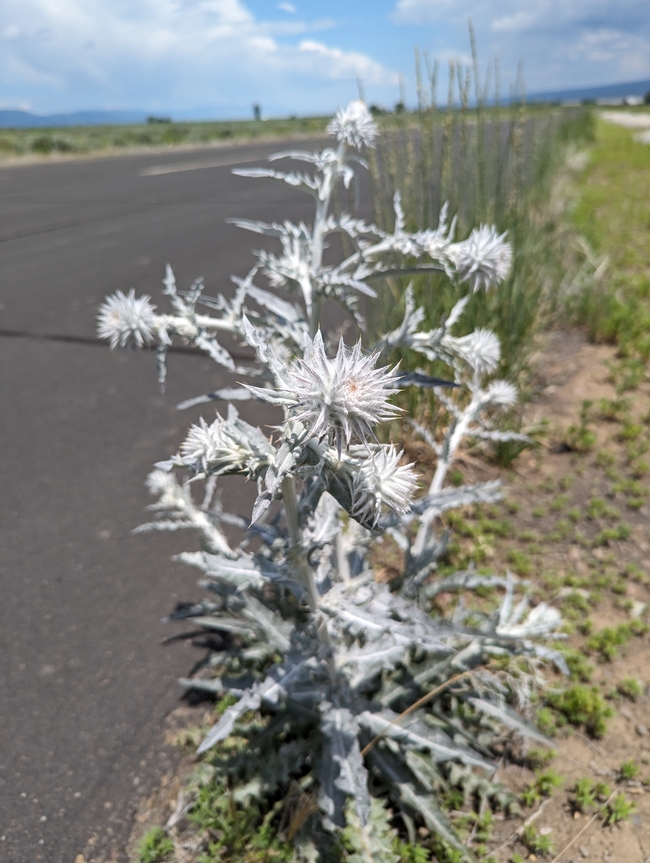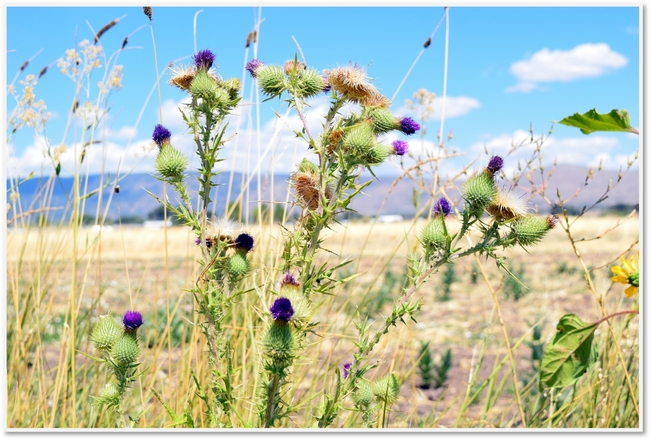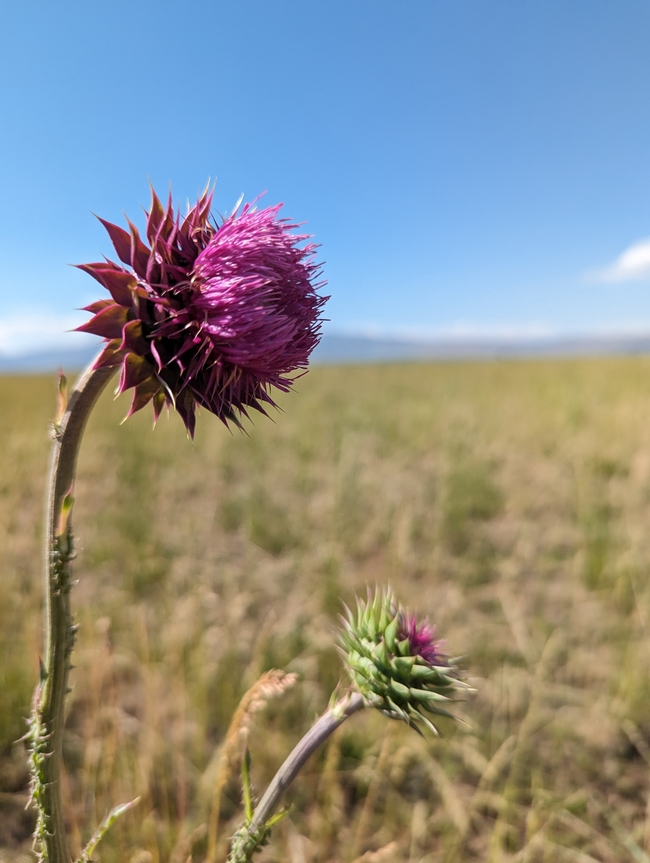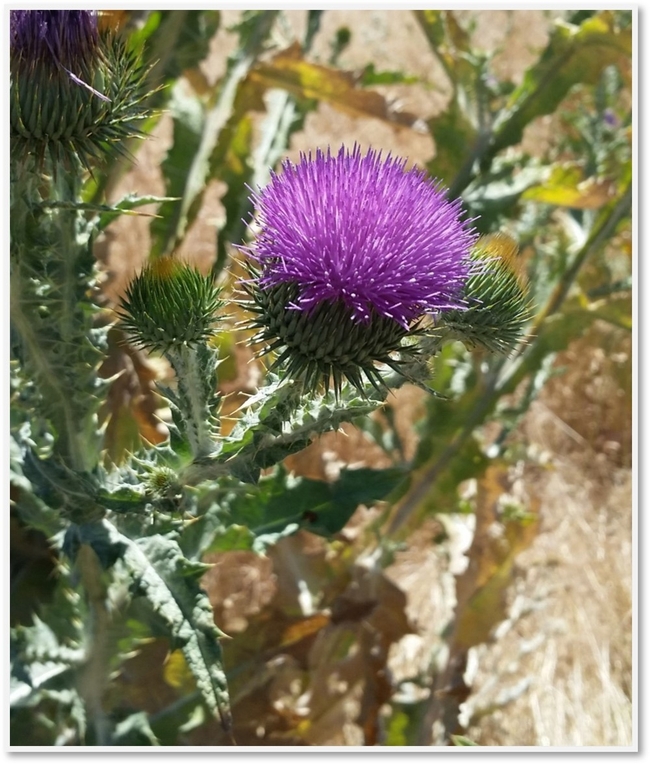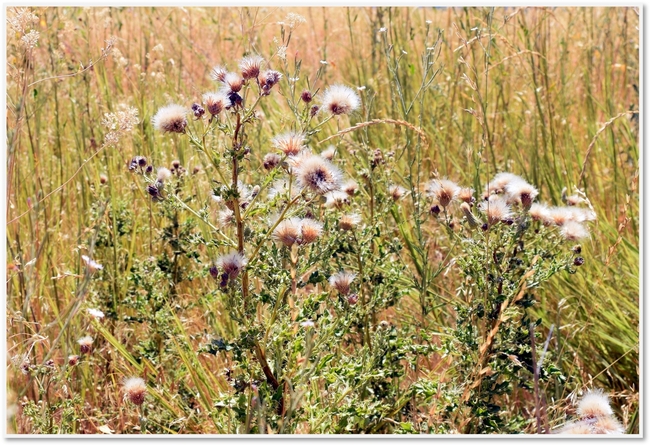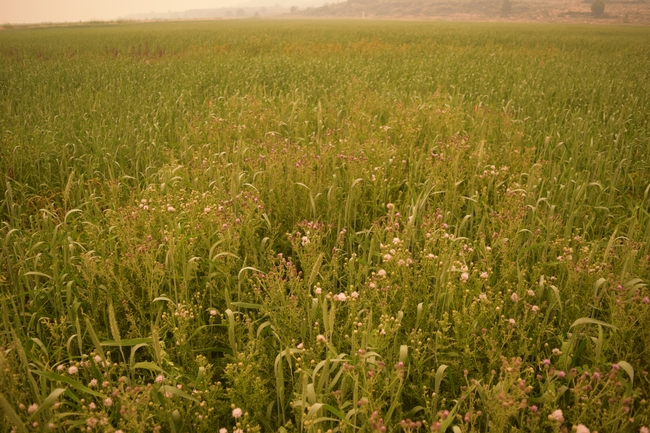Ten years ago, Guy Kyser wrote an excellent blog on the identification of Northern California's “Big Three” invasive thistles. I encourage you to check it out, if I recall correctly, it is one of the most viewed blog posts ever posted on the UC Weed blog, which is impressive!
Driving back home from Quincy yesterday, in the Dixie fire scar on Hwy 70, there were hundreds of native “snowy thistles” growing along the steep slopes clinging to the rocks. This has to be one of my favorite plants since moving to California. Stark white, covered in hairs, with a vibrant pink flower, it looks like something out of a Dr. Suess book! The first time I saw a snowy thistles, I made the person who was driving slam on the brakes and flip a U-turn so I could check them out.
Picture one: Snowy thistle in Surprise valley on a roadside before it bloomed. Look at how dense the white hairs are!
Here in Northeastern California we have a boatload of native thistles, and doing a quick search for thistles on Cal-flora will produce a list of over 20 native thistles, as well as quite a few non-native thistles. It really is important to be able to identify the difference between the good ones and the bad ones.
First, I would like to highlight four of the non-native thistles I get the most questions about controlling, and only one, Bull thistle (Cirsium vulgare) overlaps with Guy's list.
Picture Two: Bull thistle in the Honey lake Valley, observe the onion/bulb shaped seed heads.
Bull thistle is pretty widespread, and while it can form dense patches, often it does not. It typically grows as a biennial, and is around 3 feet tall (sometimes taller). Bull thistle has a deeply serrated leaf, with onion shaped flower heads. I will mention that the head shape/size can really set it apart from the other thistles I'll mention.
The next biennial thistle is Musk thistle (Carduus nutans). Lower leaves on rosettes often have a whitish tinge on the margins. It can grow quite tall (over 6 ft. if moisture is available), and flowers are large and typically perched on individual stalks. The bracts below the flower heads are large and distinctive compared to the other thistles, and the bottom of the flowers are somewhat flattish.
Picture Three: Musk Thistle in a pasture in Sierra valley, look how large and distinct the bracts are at the base of the flower.
Another, Scotch thistle (Onopordum acanthium) is probably the worst of the biennial thistles because of its decades long lived seed bank. When it grows tall people describe it as a “Christmas tree” and folks will literally chop them down with axes if they are not controlled when young. I have seen plants 8 ft. tall with bottom stalks 5-6 inches in diameter. However, it doesn't always grow this tall and under moisture stress will produce seeds on plants only a foot or two high. It has more of a blueish grey tinge to the foliage which are covered in numerous hairs. The main stems are winged. Flowers heads are typically bigger rounder and flatter than Bull thistle, but not as flat as Musk thistle with much smaller bracts. The foliage of the Scotch thistle really sets it apart from the other two.
Picture Four: Scotch thistle in Long Valley, notice the rounder seed heads and hairy blueish grey leaves.
Lastly is Californian thistle. Just kidding… but not really! Cirsium arvense, what we call Canada thistle in the states is called California thistle in New Zealand. It doesn't come from California or Canada, but instead Eurasia, but I guess it is fun to blame your thistle problems on other places! This thistle is the only perennial on the list, and has a deep creeping root system. Leaves are typically smaller than the other three and flowers are much smaller often growing in bunches or clumps on a plant. Flowers are most typically purple, but occasionally you can get white blooms. The underside of the leaves are covered in white hairs. Canada thistle is terribly problematic in both cultivated production and wildlands.
Picture Five: Close up of smaller Canada thistle heads in the Honey Lake Valley. Heads can be onion shaped, to round, but are smaller than the biennial thistle heads above.
Picture Six: Canada thistle in Willow Creek Valley during the Dixie fire in a triticale field. Notice the smaller leaves small seed heads in clumps with purple pink and whitish flowers.
Cal Flora/Cal Photos is a great place to get some pictures of various thistles, native and non-native to make sure you know what you are dealing with. I know quite a few folks that spray or dig all thistles, which is not ideal as the natives can be beautiful and provide good pollinator habitat!
